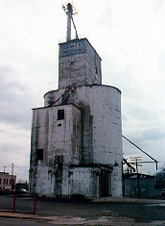
 | Markets are places where farmers sell their agricultural products. Before 1795, farmers sold their products in local markets. Farmers would take their grain by horse-pulled wagon to grain elevators which were usually no more than ten miles from the farm. They would sell their livestock in local markets, too. After 1795, local markets began to dry up and farmers needed to find new places to sell their goods. |
| 1795 The Pickney Treaty gives Americans free navigation of the Mississippi river | |
| 1801 514 flatboats travel from Ohio to New Orleans to trade products | |
| 1835 The Welland Canal is opened up, allowing Knox County to become part of the "Wheat Belt" |
"Ohio's unique geographic location enables it to use three avenues for overseas shipment: Great Lakes and St. Lawrence Seaway, Ohio and Mississippi Rivers to Gulf Ports, and unit trains to east coast ports."
Canals: The Answer to the Problem?
In 1801, 514 faltboats traveled to New Orleans filled with barrels of flour and salt pork, the only products which could be preserved in these barrels. Unfortunately Ohioans had many other products they wanted to sell. Agriculture was hurting in Ohio because there weren't any markets closer than New Orleans and New York. In 1805 hard times settled on Ohio and lasted for the next thirty years. Ohio decided that building canals was the solution to this problem. A canal is built to let boats navigate the water, carrying goods to be bought and sold. The success of the Erie Canal System in New York led to the development of many canals throughout Ohio. By 1833 Ohio had four hundred miles of canals which gave farmers easy access to markets throughout Ohio. Canals were widely used to expand the market until they were replaced in the 1850's by railroads.
Railroads: Quick Transportation of Farm Goods
![]() Railroads were able to get produce, livestock, and other goods to markets in and outside Ohio quickly. By 1856 railroads completely replaced canals for transpoting farm goods to markets. The use of railroads did not diminish until road improvements made trucks the primary method for moving farm products to markets.
Railroads were able to get produce, livestock, and other goods to markets in and outside Ohio quickly. By 1856 railroads completely replaced canals for transpoting farm goods to markets. The use of railroads did not diminish until road improvements made trucks the primary method for moving farm products to markets.
Trucks: An Opening to the World
In the late 1940's, after the Great Depression, farmers began to buy trucks to drive their products off the farm to elevators all over the country. Road improvements allowed larger shipments to go farther from the farm. In the 1940's the United States also began to build large ports so that agricultural products could be shipped overseas. A port is a city or town where products from the farm can be loaded on to ships. This allowed farmers to sell their products in the global market. Selling goods in the global market means that farmers can sell their products anywhere in the world. To understand what makets are like now, look at the commodities market.

| What happens when the number of farm products a farm can produce goes up, but not as many people want to buy the products? How do farmers respond to this problem? | |
| Find a map and see how far you are from Boston, New Orleans and New York. How long would it take a truck driving 65 mph to get to each of these places? If gas is $1.25 per gallon and the truck can drive 50 miles per gallon, how much would it cost to drive the farm products to each of these places? | |
| If a farmer takes 8 bushels of corn to the local market and receives $145 how much money per bushel does the farmer receive? If the same farmer wanted to sell his products to a market 50 miles away and he has to pay $1.25 for gas and $15 for a driver and he still only gets $145, how much money per bushel does the farmer receive? |
 | Take me back in time! |

